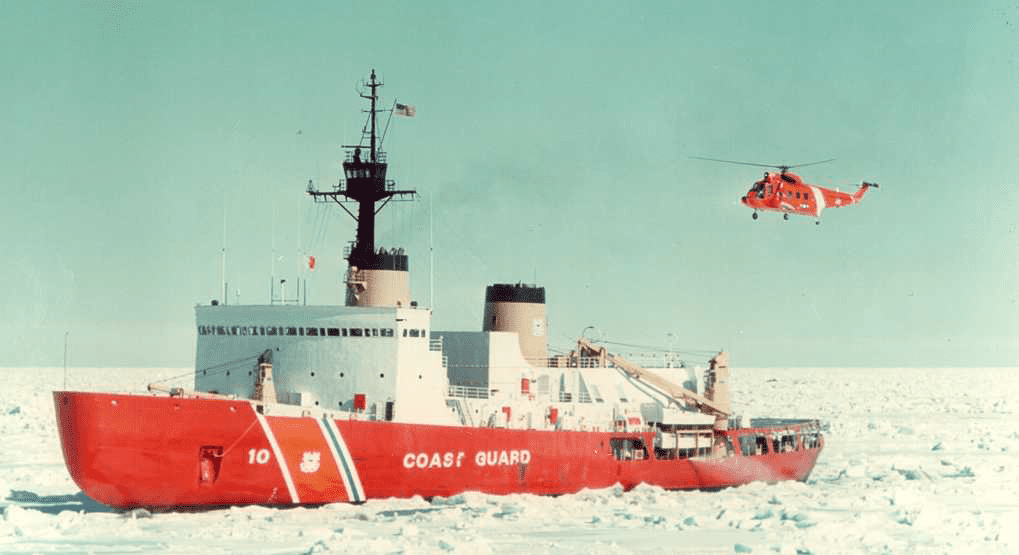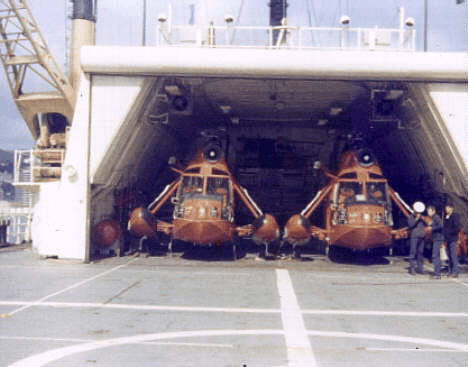
The Coast Guard’s first ship-helicopter operations were on icebreakers. In December 1946, the CGC Northwind participated in the U.S. Navy’s Operation High Jump, the largest Antarctic expedition ever. Northwind carried a Grumman J2F-6 “Duck” airplane and a single Sikorsky HNS-1 helicopter. The aircraft’s job was ice reconnaissance: to fly ahead of the ship and identify ice leads that would allow safest passage. The HNS helicopter was much easier and faster to launch and recover than the Duck, and soon became an invaluable asset. Northwind’s Captain reported, “ The helicopter was the best piece of equipment ever carried on ice vessels.”
The Northwind was one of four ice breakers designated the “Wind Class.” The first, the Westwind was launched in 1936. The  Eastwind, Northwind, and Southwind, followed and were built for the Coast Guard. Three additional icebreakers in this class were built for the Navy. During World War II, the Westwind, and Southwind were lend-leased to the USSR. After the war the Navy and the Coast Guard shared polar icebreaking operations in support of arctic operations. The Coast Guard icebreakers were under Navy control. The Navy provided pilots and helicopter support utilizing a wide variety of helicopter types. After 1946 the Northwind assumed the primary duty of the Alaska Patrol. The Mackinaw, similar to the Wind Class but not part of it was designed and built to operate on the Great Lakes. It was decommissioned in 2006 and replaced by a newly launched icebreaker which carries the same name. The Helicopter support on these two vessels was provided by the Coast Guard.
Eastwind, Northwind, and Southwind, followed and were built for the Coast Guard. Three additional icebreakers in this class were built for the Navy. During World War II, the Westwind, and Southwind were lend-leased to the USSR. After the war the Navy and the Coast Guard shared polar icebreaking operations in support of arctic operations. The Coast Guard icebreakers were under Navy control. The Navy provided pilots and helicopter support utilizing a wide variety of helicopter types. After 1946 the Northwind assumed the primary duty of the Alaska Patrol. The Mackinaw, similar to the Wind Class but not part of it was designed and built to operate on the Great Lakes. It was decommissioned in 2006 and replaced by a newly launched icebreaker which carries the same name. The Helicopter support on these two vessels was provided by the Coast Guard.
In 1965 the Navy offered to turn all icebreakers over to the Coast Guard with the stipulation that the Coast Guard provide all helicopter support. At the time there was a question of HH-52 compatibility for polar operations. Two HH-52s, the Coast Guard’s primary helicopter at the time, were placed aboard the Eastwind on its 1965 Antarctic expedition to evaluate the feasibility of using them. The aircraft proved capable but logistics and support requirements had to be addressed A second deployment was made during Antarctic operations in 1966-67 to determine the support necessary to sustain a two- helicopter detachment over a six month shipboard deployment. The Navy icebreakers were transferred to the Coast Guard in 1967.
With the success of the evaluation deployments the Coast Guard purchased HH-52A aircraft for this purpose, and provided for personnel and support equipment. Since the icebreaker fleet was home ported in four different locations it was decided to form a helicopter support unit at a central location. The helicopter Icebreaker Support Section (IBSEC) was established at Air Station Mobile in 1969. The section had thirty officers, ninety-one enlisted personnel, and fourteen HH-52A helicopters. Pilots and aircrew trained for Cold Weather Survival, Mountain and Rough Terrain Operations, Helicopter External Load Operations, and Shipboard-Helicopter Operations, including flight, maintenance, and deck handling. Detachments were formed with two helicopters, four pilots, and ten enlisted aircrewmen. A Deployment Icebreaker Kit was created for each detachment, which included the necessary spare engines, transmissions, rotor blades, parts, and supplies to ensure a two-helicopter operations in the shipboard and isolated environment for periods in excess of six months.
After the initial deployments had returned work began on writing a handbook for future Detachments. When the first detachments deployed there were few rules to operate by other than the standard rules and regulations for fixed base helicopter operations and common sense. The Polar operations and ship movement required modifications to safely accomplish the mission. The Deployment Icebreaker Kit was reviewed. Items were added and unnecessary ones were removed. Survival gear was similarly reviewed. From this the IBSEC Manual was created. The IBSEC was later assigned the additional responsibility of training the entire deck equipped cutter fleet and the IBSEC Manual was adapted to a service wide publication, the Ship/Helicopter Operational Procedures Manual (CG-419).
The Section was renamed the Ship Helicopter Division (SHOPDIV) in 1973, when deployments also included law enforcement Patrols aboard high endurance cutters (WHECs). In 1977, the division returned its primary mission to icebreaker support and received the title, Polar Operations Division (POPDIV). The HH-52As were operated until 1989, when the HH-65A “Dolphin” helicopters replaced them.
During January of 2005 the Polar Operations Division was disestablished. The reason for the closure was primarily the result of a continuous effort to balance resources against expanding operational requirements. The timing of the decision was driven by an immediate need to flow HH-65 operational capacity into gaps created by the engine replacement project. During the period 1966 to 2005, 1400 aviators completed 162 deployments safely conducting flight operations in the world’s most extreme environment, making the difficult seem routine, and leaving a legacy of accomplishment and discovery that will remain an enduring highlight of Coast Guard aviation history.
Red and White Helos
By: CAPT Bob Watterson, CG Av 891
When a contracted Madison Avenue PR firm, in the early 60’s, advised the CG to change its operating unit livery to white with a red, white & blue racing stripe, all boats, ships and aircraft were configured accordingly.
The Icebreaker Support Unit (IBSU) was established at CGAS Mobile in 1968 to provide helo support for our 7 arctic icebreakers. At the direction of the CO, the unit’s name was immediately changed to the Icebreaker Support Section (IBSEC) and was comprised of 14 pearly white HH-52’s, and the station’s name was changed to the Aviation Training & Support Center Mobile (ATSC).
I took out IBSEC Detachment 4 with 2 white HH-52’s (Red Devils), and embarked on CGC Staten Island which departed Seattle in June ‘69 for a planned 3 month deployment in the western Arctic.
When CGC Northwind broke down, Staten Island (white) was assigned to replace her as escort for the SS Tanker Manhattan (black) in company with the Canadian Icebreaker John A. McDonald (red) for the first commercial transit of the Northwest Passage. Detachment 4 eventually debarked Staten Island in New York in October ‘69.
Among the many post-deployment projects that we undertook, was the hosting of an inter-service Arctic Helicopter Operation Safety & Survival seminar here at Mobile. I was assigned to coordinate this seminar and one of the results was a recommendation to CGHQ to reconfigure the IBSEC helos in a red color scheme. As documentation for this recommendation, I provided an aerial photo showing the 1000 foot black Manhattan being trailed through the icepack by the red McDonald, with a gray exhaust cloud as tail end Charlie indicating the position of the white Staten Island. Of course, the white HH-52 (Red Devil 2), on final for landing, could not be seen at all! In an almost predictable response from EAE, after a few months of pontification, we were advised that the recommendation was disapproved, pending the completion of an in depth study of a “high conspicuity color scheme for all helos.” In one of my more reasonable reactions to this response, I replied that, “in the interim, why not paint the IBSEC helos red, a color which doesn’t exist in the Arctic environment and also was used by the Navy and Army and therefore of great assistance in locating my helo (young butt) in the event of a forced landing on the endless white of the icepack?” Much to my delight, about a year later, an all Red (Orange) HH-52 was delivered to IBSEC from ARSC! On its starboard side, behind the open door, was stenciled “Approved by Sunkist!” The decision had been made that since the number of helos (14) assigned to IBSEC was significant, these could be treated specially.
Subsequent deployments, both aboard all cutters (WAGB, WHEC & WMEC) and while visiting other air stations, indicated that the airborne image of the red (orange) helos significantly enhanced their all around conspicuity. As the number of helos required for icebreaker deployment dropped with the decommissioning of all but two icebreakers, the general deployment for all shipboard operations increased and the decision to convert all HH-52’s to this color scheme was made. On the retirement of the HH-52 and its replacement by the HH-65 Dolphin, this color scheme has been implemented for all of our Short Range Recovery (SRR) helos.
As a footnote, immediately after our receipt of that first Red (Orange) helicopter, we recommended that, to improve our ability to locate an icebreaker in the icepack, consideration should be given to painting them red also! We used the same aerial photo to support this recommendation.
